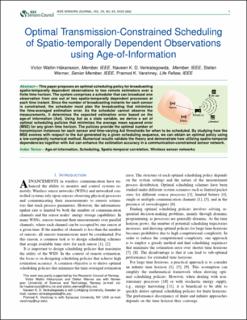| dc.contributor.author | Håkansson, Victor Wattin | |
| dc.contributor.author | Dasanadoddi Venkategowda, Naveen Kumar | |
| dc.contributor.author | Werner, Stefan | |
| dc.contributor.author | Varshney, Pramod K. | |
| dc.date.accessioned | 2022-12-29T15:50:25Z | |
| dc.date.available | 2022-12-29T15:50:25Z | |
| dc.date.created | 2022-07-06T11:48:30Z | |
| dc.date.issued | 2022 | |
| dc.identifier.issn | 1530-437X | |
| dc.identifier.uri | https://hdl.handle.net/11250/3039960 | |
| dc.description.abstract | This paper proposes an optimal scheduling policy for broadcasting spatio-temporally dependent observations to two remote estimators over a finite time horizon. The system comprises a scheduler that can broadcast one observation from one out of two spatio-temporally dependent processes at each time instant. Since the number of broadcasting instants for each sensor is constrained, the scheduler must plan the broadcasting that minimizes the time-averaged estimation error. As the scheduler cannot observe the measurements, it determines the expected estimation error based on the age-of information (AoI). Using AoI as a state variable, we derive a set of optimal scheduling policies that minimizes the average mean squared error (MSE) for any given time horizon. The policies provide the optimal number of transmission instances for each sensor and time-varying AoI thresholds for when to be scheduled. By studying how the MSE evolves with respect to the AoI generated by a given scheduling sequence, we can obtain an optimal policy using a low-complexity numerical method. Numerical results validate the theory and demonstrate how utilizing spatio-temporal dependencies together with AoI can enhance the estimation accuracy in a communication-constrained sensor network. | en_US |
| dc.language.iso | eng | en_US |
| dc.publisher | IEEE | en_US |
| dc.title | Optimal transmission-constrained scheduling of spatio-temporally dependent observations using age-of-information | en_US |
| dc.title.alternative | Optimal transmission-constrained scheduling of spatio-temporally dependent observations using age-of-information | en_US |
| dc.type | Peer reviewed | en_US |
| dc.type | Journal article | en_US |
| dc.description.version | acceptedVersion | en_US |
| dc.rights.holder | © IEEE. Personal use of this material is permitted. Permission from IEEE must be obtained for all other uses, in any current or future media, including reprinting/republishing this material for advertising or promotional purposes, creating new collective works, for resale or redistribution to servers or lists, or reuse of any copyrighted component of this work in other works. | en_US |
| dc.source.journal | IEEE Sensors Journal | en_US |
| dc.identifier.doi | 10.1109/JSEN.2022.3186755 | |
| dc.identifier.cristin | 2037355 | |
| cristin.ispublished | true | |
| cristin.fulltext | postprint | |
| cristin.qualitycode | 2 | |
